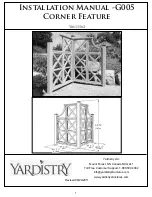
Appendix A — Technical Aspects
81
QuadStat
The QuadStat comprises four subunits which function in potentiostat
mode only — that is the QuadStat cannot be used as a galvanostat. A
block diagram of the QuadStat construction is shown in
Within the QuadStat an ‘error voltage’ is generated from the difference
between the voltage on the Reference electrode and ground (0 V). This
error voltage drives a high gain amplifier (VCVS – voltage controlled
voltage source) the output of which is applied to the Counter electrode
(CE) in such a way as to minimise the error voltage.
The QuadStat, and the electrochemical cell to which it is connected,
form a composite feedback control system in which the value of the
Counter Electrode (CE) voltage is controlled in such a way as to make
the Reference voltage, with respect to the Working electrode, equal to
the desired Command voltage. The current flow (I) in the Working
Electrode (WE) is the quantity being measured. A DAC provides a
means to offset (zero) this current signal so that small current signal
variations can be more accurately determined.
Overload
Auxiliary
Reference
Working
Online
Dummy
Cell
Hi Z
Ref Amp
Gain
Power Amp
Error Voltage
Subtractor
Overload Detector
Front Panel
Back Panel
E In
(Command
voltage)
E Out
(Working
voltage)
I Out
I
2
C Input
I
2
C Control
Interface
Low–pass
Filter
I to V
+
–
I
2
C Output
Shield
Shield
I Offset
E Offset
+
–
+
+
To QuadStat channels 2, 3, and 4
Σ
+
–
DAC
DAC
PGA
+
–
Σ
Σ
Figure A–3
Block diagram of the
QuadStat, Channel 1.
Summary of Contents for e-corder
Page 62: ...58 eDAQ Potentiostats ...
Page 88: ...84 eDAQ Potentiostats ...
Page 94: ...90 eDAQ Potentiostats ...
Page 102: ...98 eDAQ Potentiostats ...
















































